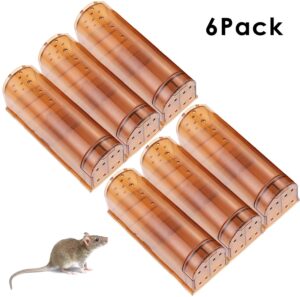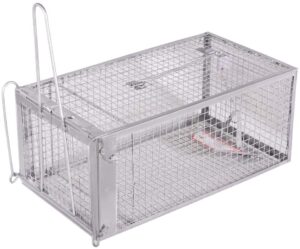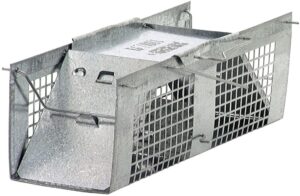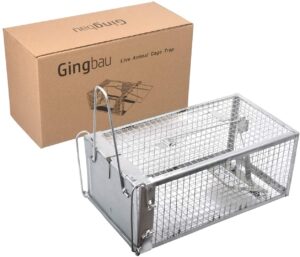Table of Contents
For those who don’t have the heart to kill mice, the best solution is a live trap. Such traps are made to cage the mouse so you can release it somewhere. It’s less messy than snap traps or poisoning the pests. Also known as catch-and-release mouse traps, these options save users from the stench of a mouse carcass. If you want to use this method, I’ve reviewed five options below, so you no longer have to wonder where to buy humane mouse traps.
| TRAP | BRAND | EXPERT RATING | CHECK PRICE |
|---|---|---|---|
 | Our Top Pick! FPS Tin Can Live Mouse Traps | Check Price | |
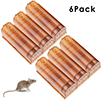 | HUX EYE Human Mouse Traps | Check Price | |
 | Wanku Large Humane Mouse Trap | Check Price | |
 | Havahart Two-Door Live Mouse Trap | Check Price | |
 | Gingbau Live Rat Cage | Check Price |
Do catch-and-release traps work?
Humane traps are good options if you don’t want to kill the mouse. Depending on the construction and design of the trap, it’s efficient in catching the rodent. However, you have to be careful not to leave your scent in it. Placement is also a critical aspect of achieving results with this kind of trap.
However, many are divided whether humane traps work or not. For the most part, the idea is trapping the mouse, then releasing it far from your home. Basically, you’re just bringing the infestation somewhere else. Sure, it works for your home, but someone else’s house might be infested unless you can bring the critters in the middle of the woods.
Also, the efficacy of these mouse traps depends on how you use it. Below, I discuss some tips to ensure that your mouse traps will work and yield catches.
Why use live/human traps?
Catch-and-release traps have a lot of benefits. Despite the extra hassle of releasing the mice away from your home, the pros outweigh the cons. The following are the benefits of using catch-and-release traps:
Reusable. Unlike sticky glue traps, catch-and-release traps are reusable. We have several of these traps that we purchased about 7 years ago and are still in service.
Catch dozens. Live traps come in different sizes, which allows you to catch multiple mice at a time. You can also purchase dozens of traps to place around your home.
Animal-friendly. For those who can’t hurt a mouse, a catch-and-release mouse trap is a good choice. It simply isolates the mouse so that you can release it in a different place.
Less mess. Other mice extermination methods like poisoning, baiting, and snap trapping are messy. It will make mouse blood and droppings spread all over. Aside from being a gross sight, it will also expose you to possible diseases if you happen to get in contact with the critter.
What to look for humane mouse traps?
When buying catch-and-release mouse traps, you must consider the following points:
Proper size
Size is the most important consideration when buying any rodent trap. Depending on the species, mice can grow between 8.8 cm and 10 cm. You must find a trap that won’t just fit the rodent inside, but also allow it to move a little. Also, the extra size will reduce the risk of the cat escaping the trap.
Longer yet slimmer traps might be ideal if you’re placing it against the wall. Spacious traps are better for spacious spots to cover more ground.
Design that works
Next, choose the setup that will work for your home. Easy-to-setup human traps are easier to use since you won’t have to worry about snapping the door on your fingers. Choose one with a bait platform that will not fail.
Method of release
You should also consider how the mouse will be released. A two-door design is ideal so that the rat can be released on both sides. A humane mouse uses a spring-loaded door that will engage once pressure is applied on the bait platform.
Solid material
Lastly, make sure that the material is solid and won’t be chewed by the mouse trapped inside. Metal traps are the best, but make sure that it’s made of stainless steel so it won’t rust easily.
How to use a catch-and-release mouse trap
Tip #1. Don’t touch it with bare hands
When it comes to mouse traps, the human scent is your enemy. This is why you should wear a pair of gloves when placing the traps all over your home. All gloves used for washing, handling food, and medical equipment works. This will also protect you from contracting a disease if the trap has been used for a catch.
Tip #2. Don’t overdo the bait
Packing the trap with chunks of bait is like giving the mouse a free snack. A large bait will let the mice get some without triggering the trap. For the best result, I recommend a pea-size bait that will cause the trap to engage when retrieved by the mouse.
Tip #3. Placement is everything
Remember that there’s one rule when it comes to mouse traps: always place it against the wall. Most mice will not brave walking in the open. They usually work beside a wall to prevent harm. Also, by placing the trap in this position, the mouse is more likely to discover it. Aside from that, choose concealed areas where the mouse will not suspect that a trap is waiting.
Tip #4. There’s power in the numbers
The more traps there are, the higher the chance that the mouse will be caught. Setting up multiple traps are necessary, regardless if your home is infested with a single mouse or a whole mischief (a group of mice). You can place two traps side by side.
However, if nights are going by without a catch, you should shuffle the placement spot. You should observe the mice’s activity and path to know where you’re supposed to place the traps.
Tip #5. Make the mouse comfortable first
On the first night, put bait inside the trap, but don’t set the gates. Establish the eating habit first for a night or two. After that, you can set the trap, but make sure that you wear gloves so the mouse won’t sniff your scent.
How to release caught mice
Your job doesn’t stop after catching the mouse. You need to release it so it won’t infest your home again. Other homeowners will poison the rat and bury it in their yard. However, if you prefer the humane way, you should release the mice at least 100 yards away from your home. You can drive farther if you want to be safe.
If releasing isn’t possible, you can commission a pest control company or a local shelter to euthanize the rodents. Calling a pest control company for mice disposal is necessary if you’ve been catching dozens after dozens in your home.
Most mice released away from its point of harborage will struggle to find food. Some of them will die in the process.
Where to Buy Human Mouse Traps? Here are 5 Best Picks!
OUR #1 CHOICE
OUR TOP PICK: FPS Tin Can Live Mouse Traps
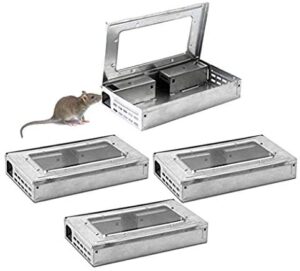
Product Name: FPS Tin Can Live Mouse Traps
Product Description: If you're looking for a humane mouse trap, you should consider the FPS Tin Can Live Traps. It's made of durable tin that will not be chewed by any rodent. This set comes with four traps with a top opening design. This low-profile mouse trap can be used under crawlspaces, against the wall, and other smaller areas. Simply dab a small amount of peanut butter inside, and it's all set. This is a great option for mice, but not for larger rats. What I like the most about this trap is it doesn't require setup. It utilizes a teeter-totter door that slides open when the mouse enters, but it will not open when the critter tries to exit. More mice can enter, and the door will work the same.
Offer price: $$$
Availability: InStock
-
Efficiency
-
Design
-
Value for Money
Overall
Summary
For this live mouse trap, there are two entryways and a large holding chamber. This one has a transparent top lid that lets you check if you’ve caught a mice.
To release the trapped mice, simply swing the top open. It’s also easier to clean and will have less mess than snap traps.
However, FPS claims that each of these traps can catch 30 mice, which I doubt, judging its size. But if you put up multiple traps, you can definitely catch more than that.
Pros
Teeter-totter door mechanism
Two entryways
Transparent top
Cons
None so far
RUNNERS-UP
HUX EYE Human Mouse Traps
Another option that I recommend is the HUX EYE Mouse Traps. It’s a sealed mouse trap that prevents mice droppings and urine from spilling. It’s also a safer choice if you have a small kid or a pet at home. You can place it in your living room, kitchen, and just about anywhere.
Moreover, it has an easy-to-set design. Simply add peanut butter inside the cubicle with a door at the other end. This is made of durable plastic that can’t be chewed by rats. Once you’ve released the mice, clean it, and use it again.
This trap utilizes a spring pivot door for an easy release. The door on the other end is sliding up with a small spot where you can place the bait. It’s also perforated to let the mouse breath, preventing death.
Take note that this mouse trap is suitable for house mice only. Larger mice species like field mice may not fit inside.
This set comes with six traps for guaranteed catches. Each trap is 6.7 x 2.4 x 2.8 inches. Meanwhile, the entrance is 1.97 x 1.97 inches wide.
Wanku Large Humane Mouse Trap
If you want to use a traditional trap, you won’t go wrong with the Wanku Large Humane Mouse Trap. This trap is 12.6 x 7.5 inches and can be used for mice, rats, squirrels, and other rodents of the same size.
Moreover, this trap uses a pedal design that will pull the compression bar and close the door when a rodent steps on it. It’s designed to prevent escape and increase catches.
Unlike other flimsy traps, this one is made of iron wire with a solid steel frame and walls. This design increases airflow, and it’s also easy to clean.
This can be used for both indoor and outdoor settings, thanks to its durable construction. It arrives fully assembled, so you only have to add bait and place it on the spot where the mice pass by. For the best results, place this trap on a dark spot.
To release the mouse, simply pull the door handle up. This will also reset the trap by cranking the compression bar back to its place.
Unlike other traps, you need to use a larger bait here to add more weight to the pedal without triggering it prematurely.
Havahart Two-Door Live Mouse Trap
The Havahart Two-Door Live Mouse Trap is the best solution for mice, shrews, and similar-size pest animals. It’s made of rust-resistant wire mesh and galvanized doors that will last long. It comes with steel reinforcements to ensure that the mice will not escape.
Moreover, this trap uses two gravity-action doors that let the muse enter on both ends. To set this up, place the bait at the back of the trap with the closest door closed. Next, place the trap on the spot where the mice are harboring.
Once the mouse pushes the trigger, the door will snap and trap it inside. This trap is large enough to catch two mice at once. There’s a learning curve on setting this up, but I think the hassle is worth it, considering the mice you can catch with this trap.
However, if you have small kids or pets at home, make sure that they won’t have access to this trap. Since it has a mesh design, they may get in contact with the trapped mouse.
Gingbau Live Rat Cage
My last recommendation for this roundup is the Gingbau Humane Live Rat Cage. It’s similar to the one from Wanku, which I reviewed above. It’s 12 inches long and 6.5 inches wide that can accommodate multiple mice at a time.
As a no-kill trap, it uses a pedal trap design with a compression bar on the roof. It’s a high-sensitive trigger, which will lock the door so the mouse will not escape.
Moreover, this Gingbau trap will arrive fully assembled, so the only thing to do is add bait and place it on the right spot. You can also use it for chipmunks and rats.
It’s made of stainless steel so you can use it both indoors and outdoors without rusting. It has a solid build with the mesh walls welded into the frame.
To set this up, simply pull the door handle to reset the pedal. You also have to pull the handle when releasing the mice.
If you’re looking for a rodent trap that will last for years, the Gingbau cage is a good choice. It’s affordable that you can afford several units lying around.
Frequently Asked Questions
Q: How come trapped mice keep on dying in my catch-and-release trap?
A: It’s possible that the mouse suffered from dehydration, chronic stress, and exposure to harmful temperatures. If you left the trap unchecked for days, starvation and dehydration are the potential causes of death. Also, mice trapped in the open during winter or summer will die of extreme temperatures.
Q: Will mice come back once released?
A: Yes, if you release the pest too close to your home. Releasing the mice just next to your house will defeat the purpose of trapping the rodent. It will just creep back to your home, making an endless cycle of catching and releasing. Make sure that you observe proper release, which I discussed above.
Q: Do mice learn to avoid traps?
A: Mice don’t necessarily recognize a trap, but they sure know the smell of humans. If you touched the trap and left your scent in it, the mice will find a workaround to avoid it. This will make the trap useless. It’s important to wear gloves to ensure that the mice will not sense looming harm.
Q: Do mice squeak when trapped?
A: Mice will make fast and loud squeaks when they are sensing harm, which is something a trap will make them feel. Loud squeaking is also a tell-tale sign that you’ve caught a mouse in your trap. It’s best to release it somewhere immediately, so it doesn’t die and leave droppings.
Q: How long will it take for a mouse to die in a trap?
A: A mouse will die in a cage between 3 to 24 hours. Some can endure up to 48 hours. Usually, dehydration, starvation, and exhaustion are common causes of death. Rats trapped on glue traps may die faster as exhaustion will ensue faster as they attempt to escape.
Final words
Where to buy humane mouse traps? The five options I reviewed here will surely help you catch the pest in your home. Make sure that you follow our tips for the best results.


